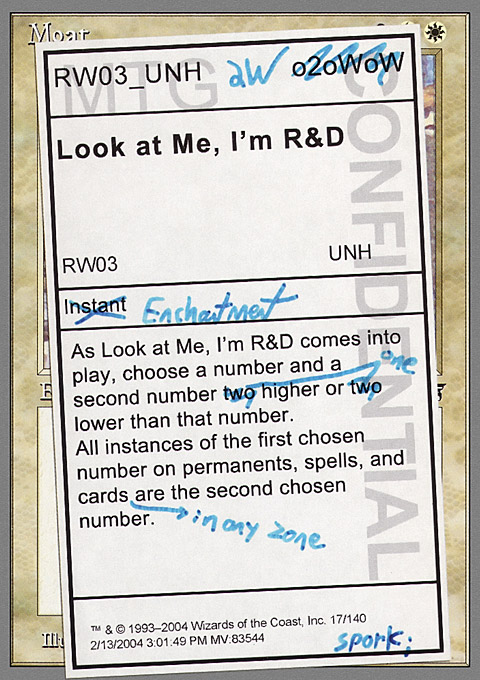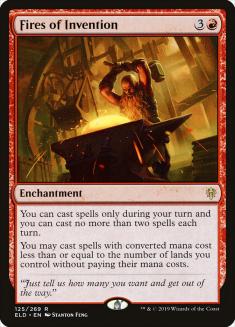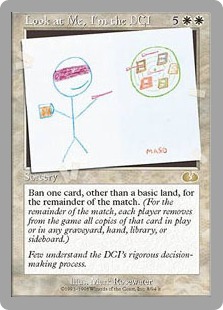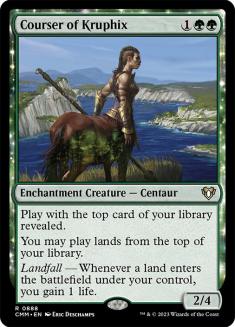It feels like it has been an eternity since Standard was a healthy format. From a control player’s perspective, Azorius Control was a force to be reckoned with after the release of Dream Trawler, but there was a monstrous deck that was waiting to be optimized. Wilderness Reclamation started to gain in popularity shortly after the Azorius Control boom and Standard quickly devolved back into chaos.
Uro, Titan of Nature’s Wrath was in the same set as Dream Trawler, but only one of those cards is played in Standard. We all knew the Simic Elder Giant was going to be problematic, just like we knew Wilderness Reclamation never should have been printed.
A quick analysis of power level, weighed against the rest of the field, yielded the information that was somehow missed by the developers. Fires of Invention; Once Upon a Time; the companion rule; Growth Spiral; Uro, Titan of Nature’s Wrath; and now Omnath, Locus of Creation are some of the most egregious printings in my long memory of the game, yet they all seamlessly fell into Standard around the same time. Each of these cards should have had the alarm sounding at the home base of production, but instead became our problem.
Bannings are painful for all parties involved, except the bottom line at Wizards of the Coast (WotC). Regardless of how many mythics they can, their sets will sell and at record rates. No colossal blowback against their sales is a true testament to the game of Magic. It’s truly the best card game ever made and it continues to be amazing, with all the turmoil in competitive play, in comparison to the competition.
We hear a lot of criticism against Magic by big personalities, asking if we want the game to become like Yu-Gi-Oh! or Hearthstone. The answer is a resounding no because we all agree that we have something special here. Management knows that the game will survive and thrive, regardless of how many broken cards are presented and how many bannings must take place.
The real losers in this exchange are the people who invest in the game. Not just the money lost from cards banned, but the time as well. Tournament numbers dwindle, folks complain about lost testing time on social media, and money is lost on entire decks dedicated to a card that is no longer legal, but none of it is bad enough to force us to collectively walk away.
It is my hope that this era of mistakes is a learning opportunity for those running the show at the top. Although the consequences for poor production are currently nonexistent, they could become real one day. A breaking point has not been established yet, and maybe there will never be one, but I am confident that future set development will more heavily consider the possibility.
The announcement for the announcement is a classic WotC move. This one should not bother us as much, since we know what’s coming. I wrote an article laying out the necessity to ban Uro. One thing that I have become skilled at over the years is identifying what cards need to be removed for format health. The drawback of such a specified talent is the double-duty I have had to pull over the last few months. Bannings in Standard have been like whack-a-mole, slamming down one threat, only to have the next, possibly worse, threat pop up. I fear that this announcement will follow the same formula.
Uro will be banned. I have no doubt in my mind that the last Simic card from that godforsaken era is getting the axe, but it will not be enough. Omnath, Locus of Creation is a four-color bombshell out of Zendikar Rising that is leaps and bounds more powerful than the competition. Uro is probably better, as a two-color investment and as a repeatable threat, but Omnath arguably packs a bigger punch. Even with Uro gone, our four-color Elemental friend will run the streets of the Multiverse with impunity.
So, what do we do? For as certain as I am that Uro is gone, Omnath is not going anywhere for a very long time. Referring to the bottom line of WotC, the flagship mythic of a new set has hexproof from bannings. Bannings may not have had the negative impact they should on the overall popularity and sales of the game, but it has never been done in Standard right after a set was released. This is a gamble that management is not willing to take, even though I suspect Zendikar Rising to continue to get gobbled up by us addicted fans who adore the game. The answer to this problem is not one that any of us will like hearing.
Omnath will be “watched” by WotC and eventually banned. “Eventually” is the time frame that we hate to hear, usually entailing months and a couple more sets being released. It can be a mixture of hubris and hope, thinking they have the solution arriving in the next set, or hoping players use the rusty, defective tools at their disposal to vanquish the enemy that cannot be destroyed by normal means. This is where we are in Standard, an era where cards are printed with too much power within the same archetype framework.
It would be a whole different ballgame if these broken cards were spread across different archetypes. Those calling for the banning of Embercleave or Lucky Clover are silly. Although these cards are very good, the difference between their effects and those of the ramp cards is astronomical.
If Mono-Red Aggro, Four-Color Ramp, Dimir Control, and Gruul Midrange all had access to an Uro, Titan of Nature’s Wrath-level card, then this conversation would never occur. Giving all the firepower to one archetype creates this imbalance, a guarantee to destroy format health. When other decks can bend the parameters of card strength, the format is in a good place. Therefore, I do not buy what the heads of Research and Development were selling earlier this year.
Earlier this year, the folks in charge were dropping polls and asking players how they felt about taking risks while developing cards. This question came about right before the first wave of bannings, asking the customers if this was an acceptable risk to enjoy more powerful cards. The framing of this argument was weak, since it was never really about a general risk-taking strategy being implemented. If it were, cards from all over the color wheel and archetype pool would enjoy the fruits of their labor. Instead, card after card landed into one of two categories.
The first category is cheating on mana, which we all know never ends well. Once Upon a Time, Wilderness Reclamation, and Fires of Invention were terrible cards that never should have seen the light of day. If we are following the same framing that they posed to the community, then the answer is no, do not take risks. Cards that allow players to easily generate a ton of mana, or cards that require no mana at all, should not be in Standard. Please, save us the heartache and keep this experimentation for Legacy/Vintage-legal sets only.
The second category is the most boring one of late: undercosted mana production on a creature that produces card advantage and wins the game on the spot if it is not answered. Why does every creature have to draw a card now? That is the question I would pose to those in charge of the game. Card draw is arguably the best general ability that any card can receive, especially if it performs some strong abilities without it. Uro, Titan of Nature’s Wrath ramps, gains life, and is a killer once it returns from the battlefield. All of this is already strong for the mana required to cast it, but adding card draw pushed it well over the edge.
Omnath falls into the same category as Uro, providing way too much card advantage for such little cost. There is no reason that this creature needs to draw a card when it enters the battlefield. It’s the automatic enhancement a green creature gets when blue is involved, but it may be time to get more creative. Soon, when both creatures meet their maker, it will be the addition of card advantage that produced their death sentence.
Tacking on card advantage to all these green creatures is a strategy that has been used for the better part of a decade. I made a joke post on Twitter related to the frustration that many of us have had with green spells lately.
I was not completely serious about this Tweet, but it does have some elements of truth to it. There is nothing wrong with increasing the overall power level of cards. This power creep is something that we have accepted, as well as supported. Even though I reminisce about the good old days with Wrath of God and Counterspell, I know the game is better without clean answers and weak threats. Strong threats have made the game far more interactive, exciting to play/watch, and generally better. The acceptance line has been crossed in recent years though, with answers being grossly underpowered, not able to come close to answering the ridiculous creatures being printed.
For Standard to be healthy again, and maintain that health for a long time, aggro, midrange, control, and ramp must have access to broken cards. This must be a rule if WotC plans to continue down this path of experimentation, pushing the boundaries of power farther than they ever have in Standard. Multiple archetypes need access to their very own Omnath to combat each other with nuclear firepower. This is the most acceptable path moving forward to meet the development goals of WotC and the reality of competitive Magic.
The alternative plan to repair format health is to ban all the perpetrators, hit the brakes on the power creep of Standard, and reduce the metagame to a collection of fair strategies with mild threats/interactions. I am obviously supportive of this solution; however, cranking up the power level has proven to be a more effective product-selling strategy. The hard truth remains that Omnath will have to get banned and it is going to cause another giant uproar. Add these development issues to the woes of Organized Play and WotC has their hands full of problems and I do feel for them.
At the end of the day, there are some magnificent mechanics and cards being developed with each passing set. For every terrible error made by development, there are a hundred amazing milestones reached, which is a big reason why I continue to love the game of Magic. The modal double-faced cards (DFCs) are an absolute slam dunk, one of the most ingenious ways to offer a new way of mana fixing. I often joke with my pals about mana fixing and how the next set will be the last wave of new lands that help out a manabase, convinced that they have had to run out of ways by now. The recent wave of lands had me floored and I had to give my people on the west coast props for doing what I thought was impossible. There are some strong folks down in production, but it is time to right the ship.
Change the formula, bring the green spells down a notch, and eliminate free mana altogether, so your sets showcase your brilliance, not your failures.








